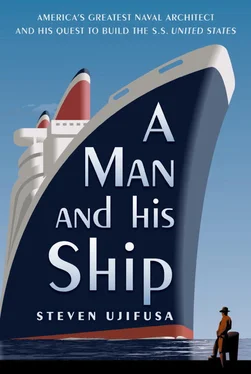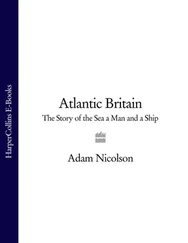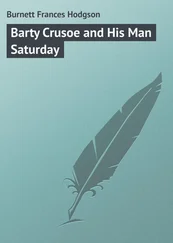Gibbs would later say of Frederic: “Everything I have done he has provided the sinews of war for.” 11
Frederic reasoned that the way to attract wary potential investors was to make a deal with a railroad. He found there was plenty of room to build a completely integrated sea-to-rails facility on the eastern tip of Long Island, at Montauk. Passengers, mail, and freight could be quickly transferred to the Pennsylvania Railroad’s trains, which would then speed to New York or other destinations. Such a terminal on Long Island would cut nearly twelve hours off any transatlantic voyage.
As Frederic laid out the financial math, his brother did more engineering calculations. To move a ship as big as his at 30 knots, the engines would have to churn out 180,000 horsepower—more than double Mauretania ’s maximum output. Not only had no engineer built such a powerful steam plant, but the astronomical fuel cost for each voyage would make the liner a coal-guzzling, money-losing monster.
There was only one system, electric drive, that might work, and there was only one person in the country who might listen to the possibility of its use on a ship. That was the chief engineer of General Electric, William LeRoy Emmet, promoter of the GE-Curtis turbo generator system used in the newest American electric power plants. The more efficient Curtis turbine was a direct challenge to the British Parsons’s bigger, slower turbine, which had recently displaced reciprocating piston engines on ships. It had never been used on an ocean liner, but Annapolis-educated Emmet might be open to trying.
Emmet wanted something big: to break Parsons’s stranglehold on ship engines and sell his improved version to the U.S. Navy. The principle he was touting with missionary fervor was “turbo-electric” power. Rather than using steam to turn a ship’s rotor directly, the Curtis turbine would use steam to turn a rotor, spinning at 2,000 revolutions per minute, to power a massive electric generator. This would in turn power a huge electric motor that would turn a ship’s propeller shaft. The motor could move at a rate slow enough for the propellers to effectively grip the water, avoiding a vibration-causing phenomenon known as cavitation—the ship’s screws turning so fast that they were generating bubbles in the water around them, creating a non-uniform medium in which to turn.
Emmet argued that electric propulsion was best suited for “vessels requiring very large power and high rates of speed reduction”—meaning either a battleship or a transatlantic ocean liner. 12But even after demonstrating the efficiency of turbo-electric propulsion in two experimental naval vessels, Emmet had no luck convincing anybody in Washington to adopt the system. President Wilson’s secretary of the Navy, Josephus Daniels, told Emmet to stop bothering him. So did Assistant Secretary of the Navy Franklin Delano Roosevelt.
As an alternative to turbo-electric power, Navy engineers tried geared turbines, which worked somewhat like an automotive gearbox. The power from the rapidly spinning rotor would then be transfered to a set of gears, reducing revolutions and preventing cavitation. The Navy design had strong bureaucratic allies. But someone among the higher-ups was looking ahead, and finally gave Emmet’s new technology a chance on the battleship USS Pennsylvania. Her sister ship USS Arizona would use geared turbines. Not until ship trials held in 1916 would Emmet know that his turbine would prove to be a big part of the Navy’s future.
Gibbs had a college friend who could provide an introduction to Emmet. 13
Emmet was ready to talk ships when the Gibbs brothers asked for a meeting. The prospect of electrically powered battleships excited Emmet, but a transatlantic superliner set his imagination on fire. He invited the two to GE’s Schenectady, New York, headquarters and sat down with them in his office at the plant sometime in 1915. The brothers bore a name that would definitely have been known to Emmet. Their father, William Warren Gibbs, had founded a major company, Exide, that sold batteries to Emmet at GE. William Warren had long ago severed his Exide connection, and it is not known if he provided a letter of introduction for his sons—or if it would have helped if he had. Sitting across from the bespectacled, mustachioed Emmet, William Francis Gibbs was on his own.
If Gibbs still had any of his old shyness, he couldn’t let it show now. This was the chance he really needed, and the earnest young dreamer laid out his case. By his calculations, he told Emmet, a liner using GE’s electric drive could produce 20 percent more speed than the famed 26-knot Mauretania. 14
Emmet was stunned. After years of dealing with the Navy bureaucracy, here was a young man who not only understood marine design, but had a vision for something really grand. The nervy Harvard dropout and failed lawyer appeared to have the real makings of a naval architect. And unlike many other engineers, he was unafraid to defy convention. The presentation had sold Emmet on more than the ship: it had sold him on Gibbs as well. 15
William Francis and Frederic Gibbs walked out of General Electric headquarters two very happy young men. Emmet told them that General Electric would help design the 180,000-horsepower electric turbines for their proposed superliners. The commitment from GE would also help get the brothers a meeting with the man best qualified to vet their hull designs: Rear Admiral David W. Taylor, chief of the Navy’s Bureau of Construction and Repair.
Taylor was well fitted to judge naval design. The son of a hardscrabble farmer in Louisa County, Virginia, he was so brilliant that he entered Randolph-Macon College at age thirteen. Five years later, he received an appointment to the U.S. Naval Academy, and graduated at the top of his class. After his sea duty, the Navy Department sent him as part of a select group to study marine engineering at the Royal Naval College in Greenwich, England, where he graduated with the highest marks ever earned by any student, foreign or British, up to that time. 16
Back in the United States, the rising naval officer devised a system of calculating ship stability and buoyancy so lucid and accurate that it became standard practice throughout the Navy. He also pioneered the U.S. Navy’s work with experimental models in hull design—looking for that “single, correctly-designed hull” that would have optimal ratios for beam-to-draft and speed-to-length. During his experiments, Taylor came up with the idea of the bulbous bow, a protrusion that stuck out from the vessel’s stem below the waterline. Rather than cutting through the water, the bulbous bow would push the water away from the hull, reducing resistance. Everything else being equal, a properly designed bulbous bow allowed a ship’s engines to be 5 percent more efficient. 17Taylor’s magnum opus, published in 1910, was The Speed and Power of Ships. William Francis almost certainly had a marked-up copy of Taylor’s book in his attic study. Now, at his first meeting with the famed engineer, he handed over his drawings for evaluation by a master.
Admiral Taylor immediately recognized that the plans were the work of an inspired amateur, but he was taken by the encyclopedic knowledge the Gibbs brothers had about the shipping business, and impressed further when he learned that William Emmet of General Electric had offered to design the liner’s power plant. And Taylor personally admired the young men’s daring in an area close to his heart—taking on the giant European liners. The admiral was well-known to be unhappy about American commercial shipbuilding, which lagged so far behind what was happening in Germany and Great Britain.
And so after tweaking the drawings, Taylor said he was willing to build a 1/24th scale model of the Gibbs vessel for testing in the U.S. Navy Experimental Model Basin at the Washington Navy Yard, with the admiral’s engineering staff providing full technical support for the engineering of the liner’s hull. Built in 1898 under Taylor’s direct supervision, the towing tank was 470 feet long and topped by a truss-and-glass ceiling. A motorized beam, set on parallel tracks, pulled a miniature hull through waves created at the far end of the tank. Engineers on catwalks would then evaluate the model’s performance in a variety of simulated sea conditions. Taylor also set up a key meeting with Secretary of the Navy Daniels, who had rebuffed many of Emmet’s earlier entreaties. 18
Читать дальше












